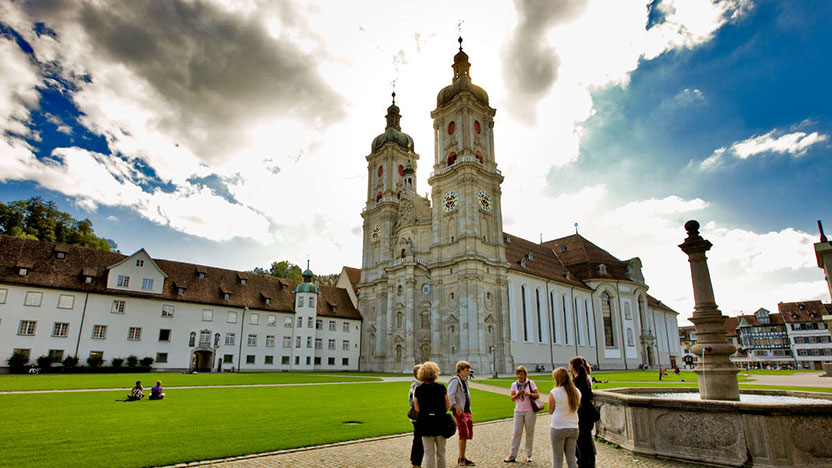http://news.nationalpost.com/life/travel/the-greatest-glacier-what-makes-switzerland-so-cool-how-about-a-23-km-chunk-of-ice

The Aletsch Glacier is called the greatest glacier of the Alps.
I thought I’d been invited as a travel writer to attend an orientation lecture for new employees learning to be guides at the Pro Natura centre.
I was told this would provide information for my article about the local flora, fauna and giant 23-kilometre Aletsch Glacier (called the greatest glacier of the Alps, capable of providing one litre of water a day to everybody on earth for six years).
But after leaving nearby Bettmeralp, a tiny village accessible only by aerial tramway, I discovered the so-called lecture was a day of field orientation — which, if offered as part of a tour, might have been described as follows:
A full-day hike: 8 a.m., return at 5 p.m. For experienced and fit hikers. Occasionally challenging terrain: small and large boulders, slippery roots, narrow and sometimes no trail, some steep sections, including time on a very uneven glacier. Pace will be set by a group of 20-yearolds. Weather forecast: sun, rain, wind, hail, snow, requiring all your protective clothing and appropriate footwear. Bring sunscreen, food and water.

Bettmeralp is a car-free village in the immediate vicinity of the Aletsch Glacier.
There was no turning back — even though I had only rubber boots.
Taking more than occasional stops, I could enjoy the tiny white, purple and orange alpine flowers, catch a glimpse of a herd of deer or a solitary goatlike chamois, or listen to the call of a cuckoo.
On to the glacier we went, and on went the crampons to give me the traction I needed to climb precipitous slopes and avoid deep icy-blue crevasses: “Don’t think, just walk,” advised one of the mountain guides, specialists in glacier exploration who had been engaged to provide in-depth information to the Pro Natura newbies.
We met unexpected wildlife, like the glacier flea, which populates pools of water, but avoids humans because we are too warm.
We learned what happens when three glaciers merge into one. The lateral moraines — matching ridges on either side of the glacier of rock, soil and sediment which have been picked up by the ice flow — join and form medial moraines. These appear as dark lines running down the centre along the length of the glacier.

Mike GrenbyA village hugs a slope of the Swiss Alps. Switzerland’s Aletsch Arena region features a blend of cultures, beautiful wildlife and world-renowned skiing.
Instructor Gregor Wittwer poured custard into a slightly sloping board cut to represent the three glacial flows, then added chocolate sprinkles to represent the lateral moraines so we could see how the medial moraine forms. Afterward, he gave everybody spoons to provide a sweet finish to the lesson. British Columbia is blessed with spectacular and rugged mountain scenery, too. But it’s the Swiss alpine traditions going back hundreds of years which provide so many memorable experiences. Most people have heard ofSwitzerland’s popular tourist attractions like Zermatt, the Matterhorn, St. Moritz and the major cities like Zurich, Geneva and Lucerne.
But very few outside Europe know about Bettmeralp (permanent population 520, growing to 3,000 in summer and 6,000 around Christmas), a village with almost no cars, accessible only by aerial tramway from the Rhone valley and 1,950 metres above sea level.
The main street runs the few hundred metres from the upper terminal of the tramway into the village. The mountains tower above the village and across the valley climb equally steep. Indeed, picture postcard perfect is the only way to describe the “sunburned” (as one local put it) chalets that cluster in the villages or cling to impossibly steep mountain slopes, their wooden exteriors having weathered into a dark, almost black brown, with flowers adorning their windows and balconies in the spring and summer, and deep snow covering their roofs in winter.

Mike GrenbySwiss alphorn players rehearse at Eggishorn, a mountain in the Alps in Switzerland’s Aletsch Arena region.
With narrow-gauge mountain trains that always run on time, cows with multi-toned bells, cheeses and chocolates and surprisingly good wines — and reaching to the sky, snow-covered mountain peaks with hiking trails on their lower slopes that attract people of all ages — Switzerland has it all.
It’s common to be out on a rugged hike and just when you are starting to feel hungry, you round a bend and find a chalet restaurant in the middle of nowhere, with a perfect coffeeand-cake combo or full lunch menu.
“Most of our visitors come from Switzerland, Germany and Holland,” said Simon Weiler, sales manager for Aletsch Arena, the southwestern portion of the country that includes the Jungfrau-Aletsch UNESCO World Heritage Site. And indeed, during my five-day stay I didn’t meet any native English speakers, although other visitors and the locals could speak English.
Still, it’s worth making the effort to say at least a few greeting words in the local lingo, which is an interesting mix of Switzerland’s four official languages (German, French, Italian, Romansh) plus Swiss-German and in this area, the Valais canton dialect.
So the German guten abend (good evening) greeting, which seems to be used from mid-afternoon on, becomes naben. And goodbye is mostly the Italian ciao.
Especially in a small place like Bettmeralp, you can expect people entering a restaurant to say hello to the diners already there. You don’t necessarily have to greet everybody you meet. But most people do, particularly if you are out on a hike.
And you never know what you will encounter when you set out. For example, on a less strenuous day than my glacier experience, I rode two aerial tramways to the Eggishorn lookout at 2,926 metres where, as luck would have it, 14 alphorn players from all over Switzerland and their conductor had gathered to rehearse. They even finished off with an informal yodel. It doesn’t get any more Swiss than that.
















